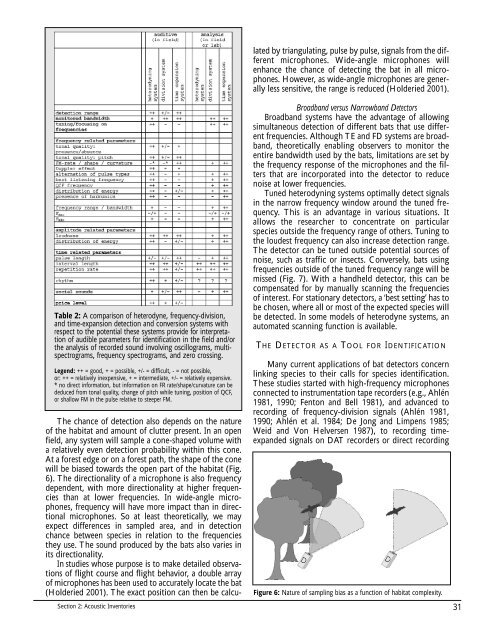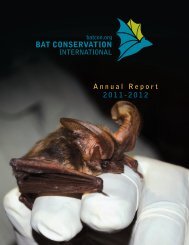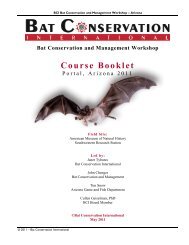Bat Echolocation Researc h - Bat Conservation International
Bat Echolocation Researc h - Bat Conservation International
Bat Echolocation Researc h - Bat Conservation International
You also want an ePaper? Increase the reach of your titles
YUMPU automatically turns print PDFs into web optimized ePapers that Google loves.
The chance of detection also depends on the nature<br />
of the habitat and amount of clutter present. In an open<br />
field, any system will sample a cone-shaped volume with<br />
a relatively even detection probability within this cone.<br />
At a forest edge or on a forest path, the shape of the cone<br />
will be biased towards the open part of the habitat (Fig.<br />
6). The directionality of a microphone is also frequency<br />
dependent, with more directionality at higher frequencies<br />
than at lower frequencies. In wide-angle microphones,<br />
frequency will have more impact than in directional<br />
microphones. So at least theoretically, we may<br />
expect differences in sampled area, and in detection<br />
chance between species in relation to the frequencies<br />
they use. The sound produced by the bats also varies in<br />
its directionality.<br />
In studies whose purpose is to make detailed observations<br />
of flight course and flight behavior, a double array<br />
of microphones has been used to accurately locate the bat<br />
(Holderied 2001). The exact position can then be calculated<br />
by triangulating, pulse by pulse, signals from the different<br />
microphones. Wide-angle microphones will<br />
enhance the chance of detecting the bat in all microphones.<br />
However, as wide-angle microphones are generally<br />
less sensitive, the range is reduced (Holderied 2001).<br />
Table 2: A comparison of heterodyne, frequency-division,<br />
and time-expansion detection and conversion systems with<br />
respect to the potential these systems provide for interpretation<br />
of audible parameters for identification in the field and/or<br />
the analysis of recorded sound involving oscillograms, multispectrograms,<br />
frequency spectrograms, and zero crossing.<br />
Legend: ++ = good, + = possible, +/- = difficult, - = not possible,<br />
or: ++ = relatively inexpensive, + = intermediate, +/- = relatively expensive.<br />
* no direct information, but information on FR rate/shape/curvature can be<br />
deduced from tonal quality, change of pitch while tuning, position of QCF,<br />
or shallow FM in the pulse relative to steeper FM.<br />
Section 2: Acoustic Inventories<br />
Broadband versus Narrowband Detectors<br />
Broadband systems have the advantage of allowing<br />
simultaneous detection of different bats that use different<br />
frequencies. Although TE and FD systems are broadband,<br />
theoretically enabling observers to monitor the<br />
entire bandwidth used by the bats, limitations are set by<br />
the frequency response of the microphones and the filters<br />
that are incorporated into the detector to reduce<br />
noise at lower frequencies.<br />
Tuned heterodyning systems optimally detect signals<br />
in the narrow frequency window around the tuned frequency.<br />
This is an advantage in various situations. It<br />
allows the researcher to concentrate on particular<br />
species outside the frequency range of others. Tuning to<br />
the loudest frequency can also increase detection range.<br />
The detector can be tuned outside potential sources of<br />
noise, such as traffic or insects. Conversely, bats using<br />
frequencies outside of the tuned frequency range will be<br />
missed (Fig. 7). With a handheld detector, this can be<br />
compensated for by manually scanning the frequencies<br />
of interest. For stationary detectors, a ‘best setting’ has to<br />
be chosen, where all or most of the expected species will<br />
be detected. In some models of heterodyne systems, an<br />
automated scanning function is available.<br />
THE DETECTOR AS A TOOL FOR IDENTIFICATION<br />
Many current applications of bat detectors concern<br />
linking species to their calls for species identification.<br />
These studies started with high-frequency microphones<br />
connected to instrumentation tape recorders (e.g., Ahlén<br />
1981, 1990; Fenton and Bell 1981), and advanced to<br />
recording of frequency-division signals (Ahlén 1981,<br />
1990; Ahlén et al. 1984; De Jong and Limpens 1985;<br />
Weid and Von Helversen 1987), to recording timeexpanded<br />
signals on DAT recorders or direct recording<br />
Figure 6: Nature of sampling bias as a function of habitat complexity.<br />
31
















